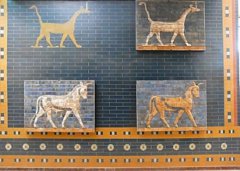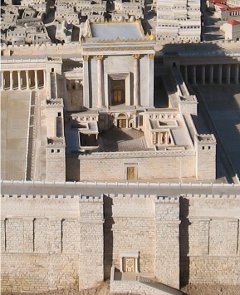1) What does the 430 days mean?

Ezekiel who is called the “son of man” acts out, or walks in visions in his prophecy. A most intriguing event is recorded in Chapter 4. He lays on his left side for 390 days and then on his right side for 40 days. What does it mean?
Against Jerusalem
The fourth chapter and prophecy begins with Ezekiel being asked to draw Jerusalem on a tile. He then is to show it under attack.
Moreover take thou unto you an iron pan, and set it for a wall of iron between you and the city: and set thy face against it, and it shall be besieged, and you shall lay siege against it. This shall be a sign to the house of Israel. (Ezekiel 4:3)
At this stage the northern kingdom of Israel had already been in captivity 127 years since the Assyrians had dispersed them. As he then goes on to speak of Judah, it does seem as if by Israel what was meant was the dispersed of Israel.
However the prophecy was delivered to the captives at Chebar first, and in chapter 3 the 'house of Israel' is defined as the whole of the Hebrew-speaking captivity,
He said unto me, Son of man, go, get thee unto the house of Israel.. For thou art not sent to a people of a strange speech and of an hard language, but to the house of Israel; .. But the house of Israel will not hearken unto thee; for they will not hearken unto me: for all the house of Israel are impudent and hardhearted. .... Moreover he said unto me, Son of man, all my words that I shall speak unto thee receive in thine heart, and hear with thine ears. And go, get thee to them of the captivity, unto the children of thy people, and speak unto them, and tell them, Thus saith the Lord GOD; whether they will hear, or whether they will forbear. (Ezekiel 3:4-11)
It seems Israel is 'all Israel in captivity', and Judah is the people of Judah who at that stage, though reduced, still possessed Jerusalem. But they were to lose Jerusalem. Ezekiel acts out a siege of Jerusalem. The facts of the siege are these,
Moreover take you unto thee an iron pan, and set it for a wall of iron between you and the city: and set your face against it, and it shall be besieged, and thou shall lay siege against it. (Ezekiel 4:3)
Ezekiel is the 'son of man', yet he is showing the God of Israel's attitude to the place where he chose to put his name.
Therefore will I do unto this house, which is called by my name, wherein ye trust, and unto the place which I gave to you and to your fathers, as I have done to Shiloh. (Jeremiah 7:14)
In effect the God of Israel had put 'a wall' of 'iron' there between himself and Jerusalem. The city was to be desolated and its people consumed for their iniquity.
The intriguing part is that Ezekiel acted out a siege against Jerusalem with his face against it as an iron pan for a length of time,
Lie thou also upon thy left side, and lay the iniquity of the house of Israel upon it: according to the number of the days that thou shall lie upon it thou shalt bear their iniquity. For I have laid upon thee the years of their iniquity, according to the number of the days, three hundred and ninety days: so shall thou bear the iniquity of the house of Israel.
And when thou hast accomplished them, lie again on thy right side, and thou shall bear the iniquity of the house of Judah forty days: I have appointed thee each day for a year. (Ezekiel 4:4-6)
Ezekiel was to in sign, 'bear the iniquity' for 430 days. He was as if behind an iron pan, a wall, against the city. We might see Ezekiel as the son of man, bearing iniquity as a priest making atonement, except for the statement that each day was in symbol or year, and that the target was the people of Jerusalem. He is sign for the people, who would bear the consequences of the iniquity of their fathers for that time. The total time is about 10 generations.

It is thought that this was the year 595BCE not long after Ezekiel's 30th year (chapter 1). This was eight or nine years before Jerusalem was utterly destroyed by Nebuchadnezzar in 586/7BCE. After Ezekiel lying as a sign on his side for over a year it would have been about 5 years to 588BCE when the city is placed under siege and 7 years till the city was destroyed. It seems the prophecy, and Ezekiel's actions are close to the time of the great deportation from Jerusalem.
The siege Ezekiel acted out was soon fulfilled. The bit that was to go on was the aspect of 'bearing the iniquity' for the specified years. Before the time of Ezekiel the prophet Jeremiah had spoken of 70 years in relationship to the whole land (including the former area of Israel),
And this whole land shall be a desolation, and an astonishment; and these nations shall serve the king of Babylon seventy years. And it shall come to pass, when seventy years are accomplished, that I will punish the king of Babylon, and that nation, saith the LORD, for their iniquity, and the land of the Chaldeans, and will make it perpetual desolations. (Jeremiah 25:11-12)
And then specifically,
For thus saith the LORD, That after seventy years be accomplished at Babylon I will visit you, and perform my good word toward you, in causing you to return to this place. (Jeremiah 29:10)
They, in fact, returned to the land and also to Jerusalem.
Seventy years does not seem to fit what Ezekiel did. So what does it mean that Ezekiel would in symbol bear the iniquity for 390 then 40 years, the whole time eating food by weight?
Silence from God
Looking back a few things emerge. Some Jews (a long way short of a majority) went back to the land after 70 years and rebuilt the temple, but there was no autonomy of any sort. The temple was at the whim of the regions foreign leaders. Alexander the Great (356-323BCE) decided to not destroy Jerusalem, but power was given to him to place the whole area in subjection.

Then also Ezekiel was a prophet, but sometime after 445BCE when the wall of Jerusalem was rebuilt or possibly as late as 391BCE there was silence. There was the famine for hearing the word,
Behold, the days come, saith the Lord GOD, that I will send a famine in the land, not a famine of bread, nor a thirst for water, but of hearing the words of the LORD: And they shall wander from sea to sea, and from the north even to the east, they shall run to and fro to seek the word of the LORD, and shall not find it. In that day shall the fair virgins and young men faint for thirst. (Amos 8:11-13)
From the time of Malachi to the next time the word was heard by Zachariah the priest in the course of Abia when he was in the Temple (Luke 1), then there is a gap of at least 390 years and possibly up to 430 years.
Jerusalem subject to foreign rule
But yet though it fits in some ways, the era might better refer to the political status of the city of Jerusalem. Even though people had returned after 70 years to the land (Jeremiah 25:11), they had no self rule and the city had no status as the place of rule. The whole of the people whether in the land, or not were in captivity. The Jews in the land, and even at Jerusalem were no less ruled by foreigners than the Jews scattered. The Jews scattered may have been free enough to be able to travel to Jerusalem, and so maintain a connection, but the whole of Israel was subject to foreign rule. Nehemiah asked for permission to do everything, and nothing to the point was done without foreign leaders acceptance of it.
While the Ptolomies seemed to have ruled lightly, the Selucids upon taking the Holy Land began to impose restrictions. Then the foreign interference became intolerable.
The oppression of the captivity for Israel overall was 390 years and 40 years was related to Judea. Curiously from 595BCE adding 390 years takes us to 205BCE. In that year Antiochus 111 defeats the Bactrians, and crushes the Medes and Persians and by creating vassal states takes the title 'the great.' Instead of a general captivity, the area called Judah and the city of Jerusalem is increasingly subjected to a process of Hellenization. Another 40 years brings us to the year 165BCE. In that year the temple, which had be defiled was famously rededicated (some sources say 164BCE). By achieving this the Jews had acquired the ability to cast off elements of the captivity.
If the time is taken from 586/7BCE the destruction of Jerusalem, it comes to the era 196-197BCE. It so happens the Rosetta stone is dated to 196BCE. In that time the struggle between Ptolemy V and Antiochus 111 intensifies leading to Antiochus 111 gaining possession of the Holy Land. In this way the general captivity of Jews becomes particular to Judea. Forty years from this point brings to 156/7BCE.

In about 156/7BCE Jonathan Maccabeus wins a great victory in Judah gaining the ability to negotiate non-interference in worship. In 157BCE Jonathan is recognised as king by the Selucids. Curiously there is no known high priest at all from the year 156BCE until Jonathan, a Kohen, steps up in 153BCE.
From the last of Ezekiel's prophecy about 571BCE to the Hasmonean state is also 430 years, but the earlier dates from the destruction of Jerusalem seem more convincing being logical in their beginning based on the context of the prophecy.
As different sources have dates one way or another by a year for the same event it is hard to be dogmatic, but it seems both the 390 and the 40 fit as eras one after the other in the pattern of events directly after the prophecy. That this era of Jewish rule after the temple re-dedication was spoken of by Daniel might support the idea that it was a reasonable end to Ezekiel's era.
And such as do wickedly against the covenant shall he corrupt by flatteries: but the people that do know their God shall be strong, and do exploits. And they that understand among the people shall instruct many: yet they shall fall by the sword, and by flame, by captivity, and by spoil, many days. Now when they shall fall, they shall be holpen with a little help: but many shall cleave to them with flatteries. (Daniel 11:32-34)
The reference to 'help', is divine help, which had not been extended for many years since sometime between 445-391BCE.

By the Common Era there was a very different situation for Jerusalem than during the captivity before 166BCE. There might be significant Roman interference, but the Jews were not in captivity in dispersion or oppressed in Judah by taxes more than any other peoples of the empire. The city of Jerusalem was attracting people as proselytes from far away including: Parthians, Medes, Elamites, people of Mesopotamia Cappadocia, Pontus, Asia, Phrygia, Pamphylia in Egypt, Libya about Cyrene and Rome, Cretes and Arabians (Acts 2:9-11) also Ethiopia (Acts 8:27), Many Jews were even 'freeborn' Romans, as Paul was (Acts 22:28). From the time Ezekiel's era of 430 ends there is an increase in Jerusalem's importance, for good reason; it was the preparation of people as Daniel spoke of,
Now when they shall fall, they shall be holpen with a little help: but many shall cleave to them with flatteries. And some of them of understanding shall fall, to try them, and to purge, and to make them white, even to the time of the end: because it is yet for a time appointed. (Daniel 11:34-35)
Other eras from Daniel then may occur.
Modern era
There is something curious in terms of the politics of the Holy Land in that 390 and 40 years can be mapped into modern times in terms of an era of aliyah without hope of a state. It is presented as a curio, as it may merely be a co-incidence. In the year 1492 Jews expelled from Spain are scattered, and some make their way to the Holy Land, then ruled by the Ottomans, and settle. Following this the expulsion also from Portugal contributes to this. Such was its scale that it is thought of as a pre-zionist aliyah. After that 390 years comes to 1882. Again there is aliyah to the land with great expectation. It takes another 40 years to come to 1922 when after WW1 the powers that existed led by Britain use international law to encourage a Jewish state. Though there were vicissitudes the law of 1922 was not repealed. But this may be a co-incidence. It does not in the same way fit the very real captivity of the house of Israel from the time of Ezekiel's captivity. The type of captivity and scarcity experienced by people after the era of the Roman Empire was slightly different to that of Assyrian, Babylonian and Perisan era. From the break up of the Roman Empire there was often a door to leaving for new lands until the modern world placed restrictions on entry.
The wonder and why it was most relevant long ago
The most remarkable aspect is that Ezekiel lay in public on his side in one place for over a year and two months and ate just enough to keep him alive, by weight, again all in public. To the generation that witnessed that it must have been a wonder that inspired awe. It was that generation who saw the events he showed first unfold. It makes sense the 430 years was to continue from that time. It seems from subsequent events that indeed that each day stood for a year of a certain type of captivity for the house of Israel in relationship to the political independence of Jerusalem. Of course there was more to come. It was written by Moses that there was to be a terrible siege after which they would be scattered.

The LORD shall bring a nation against thee from far, from the end of the earth, as swift as the eagle flieth; a nation whose tongue thou shall not understand; A nation of fierce countenance, which shall not regard the person of the old, nor show favour to the young: ....
And the LORD shall scatter thee among all people, from the one end of the earth even unto the other; and there thou shalt serve other gods, which neither thou nor thy fathers have known, even wood and stone. And among these nations shalt thou find no ease, neither shall the sole of thy foot have rest: but the LORD shall give thee there a trembling heart, and failing of eyes, and sorrow of mind: (Deuteronomy 28:49-50 and 64-65)
Other later prophecy by another son of man
After Jerusalem had gained status and some significant glory about the time of the Common Era, one who titled himself the 'son of man' like Ezekiel, while the city was at the height of the beauty built by the Herods, said of the people of Jerusalem that,
they shall fall by the edge of the sword, and shall be led away captive into all nations: and Jerusalem shall be trodden down of the Gentiles, until the times of the Gentiles be fulfilled. (Luke 21:24)
This summarised what Moses said and noted also an end. The city of Jerusalem didn't prosper for any length of time as a place of power from the time it was destroyed by the Romans until it was united 1900 years later in 1967 as the Jewish capital. We can see then progressive prophecy, so that each age is given to see the way forward for as far as is required as a warning to listen (that they not be rebellious). It is a general principle for all time from the Law of Moses (Torah) that,
If any man have an ear, let him hear. He that leads into captivity shall go into captivity: he that kills with the sword must be killed with the sword. Here is the patience and the faith of the saints. (Revelation 13:9-10).
If you liked this you might like why Isaiah walked naked 3 years?



